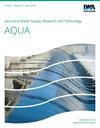Neural computing techniques to estimate the hydraulic conductivity of porous media
IF 4.3
Q2 Environmental Science
引用次数: 0
Abstract
Accurate hydraulic conductivity (K) estimation of porous media is crucial in hydrological studies. Recently, groundwater investigators have utilized neural computing techniques to indirectly estimate soil sample K instead of time-consuming direct methods. The present study utilizes easily measurable characteristics, i.e., grain size at 10 and 50% finer by weight, porosity, and uniformity coefficient as input variables to examine the efficacy of feed-forward neural network (FFNN), Kohonen self-organizing maps (KSOM), and multiple linear regression (MLR) models in estimating the K of soil samples. Model development and validation used 70 and 30% of datasets, respectively. The determination coefficient (R2), root mean square error (RMSE), and mean bias error (MBE) were used to compare the model performance with the measured K values. The study's outcome indicates that the FFNN and KSOM models better estimate the K value, while the MLR model performs merely satisfactorily. Overall, during validation, the FFNN model correlates better with the measured values having R2, RMSE, and MBE of 0.94, 0.016, and 0.006, whereas the corresponding values for KSOM are 0.91, 0.024, and −0.004, and that for MLR are 0.87, 0.024, and 0.013, respectively. Notably, the FFNN model exhibits superior prediction performance and can be employed in aquifers for precise K estimation.利用神经计算技术估算多孔介质的水力导电性
在水文研究中,多孔介质的水导率(K)的准确估算是至关重要的。近年来,地下水研究人员利用神经计算技术来间接估计土壤样品K,而不是耗时的直接方法。本研究利用易于测量的特征,即比重量细10%和50%的粒度、孔隙度和均匀性系数作为输入变量,来检验前馈神经网络(FFNN)、Kohonen自组织图(KSOM)和多元线性回归(MLR)模型在估计土壤样品K方面的有效性。模型开发和验证分别使用了70%和30%的数据集。采用决定系数(R2)、均方根误差(RMSE)和平均偏差误差(MBE)将模型性能与实测K值进行比较。研究结果表明,FFNN和KSOM模型更好地估计了K值,而MLR模型的表现仅令人满意。总体而言,在验证过程中,FFNN模型与实测值的相关性较好,R2、RMSE和MBE分别为0.94、0.016和0.006,而KSOM模型的相应值分别为0.91、0.024和- 0.004,MLR模型的相应值分别为0.87、0.024和0.013。值得注意的是,FFNN模型具有优越的预测性能,可用于含水层的精确K估计。
本文章由计算机程序翻译,如有差异,请以英文原文为准。
求助全文
约1分钟内获得全文
求助全文
来源期刊
CiteScore
4.70
自引率
0.00%
发文量
74
审稿时长
4.5 months
期刊介绍:
Journal of Water Supply: Research and Technology - Aqua publishes peer-reviewed scientific & technical, review, and practical/ operational papers dealing with research and development in water supply technology and management, including economics, training and public relations on a national and international level.

 求助内容:
求助内容: 应助结果提醒方式:
应助结果提醒方式:


